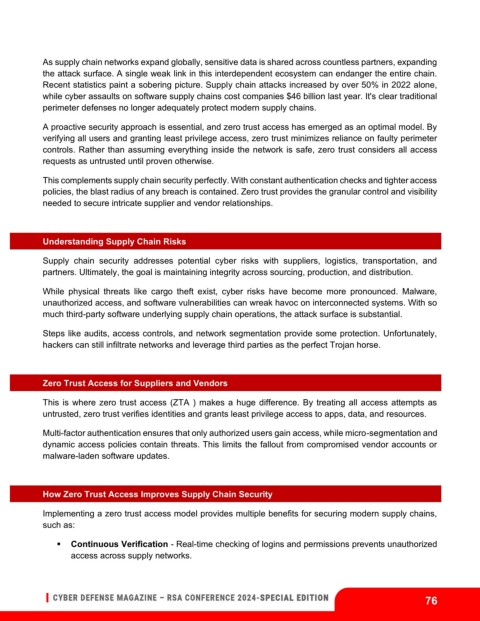Page 76 - Cyber Defense eMagazine Annual RSA Edition for 2024
P. 76
As supply chain networks expand globally, sensitive data is shared across countless partners, expanding
the attack surface. A single weak link in this interdependent ecosystem can endanger the entire chain.
Recent statistics paint a sobering picture. Supply chain attacks increased by over 50% in 2022 alone,
while cyber assaults on software supply chains cost companies $46 billion last year. It's clear traditional
perimeter defenses no longer adequately protect modern supply chains.
A proactive security approach is essential, and zero trust access has emerged as an optimal model. By
verifying all users and granting least privilege access, zero trust minimizes reliance on faulty perimeter
controls. Rather than assuming everything inside the network is safe, zero trust considers all access
requests as untrusted until proven otherwise.
This complements supply chain security perfectly. With constant authentication checks and tighter access
policies, the blast radius of any breach is contained. Zero trust provides the granular control and visibility
needed to secure intricate supplier and vendor relationships.
Understanding Supply Chain Risks
Supply chain security addresses potential cyber risks with suppliers, logistics, transportation, and
partners. Ultimately, the goal is maintaining integrity across sourcing, production, and distribution.
While physical threats like cargo theft exist, cyber risks have become more pronounced. Malware,
unauthorized access, and software vulnerabilities can wreak havoc on interconnected systems. With so
much third-party software underlying supply chain operations, the attack surface is substantial.
Steps like audits, access controls, and network segmentation provide some protection. Unfortunately,
hackers can still infiltrate networks and leverage third parties as the perfect Trojan horse.
Zero Trust Access for Suppliers and Vendors
This is where zero trust access (ZTA ) makes a huge difference. By treating all access attempts as
untrusted, zero trust verifies identities and grants least privilege access to apps, data, and resources.
Multi-factor authentication ensures that only authorized users gain access, while micro-segmentation and
dynamic access policies contain threats. This limits the fallout from compromised vendor accounts or
malware-laden software updates.
How Zero Trust Access Improves Supply Chain Security
Implementing a zero trust access model provides multiple benefits for securing modern supply chains,
such as:
▪ Continuous Verification - Real-time checking of logins and permissions prevents unauthorized
access across supply networks.
76

